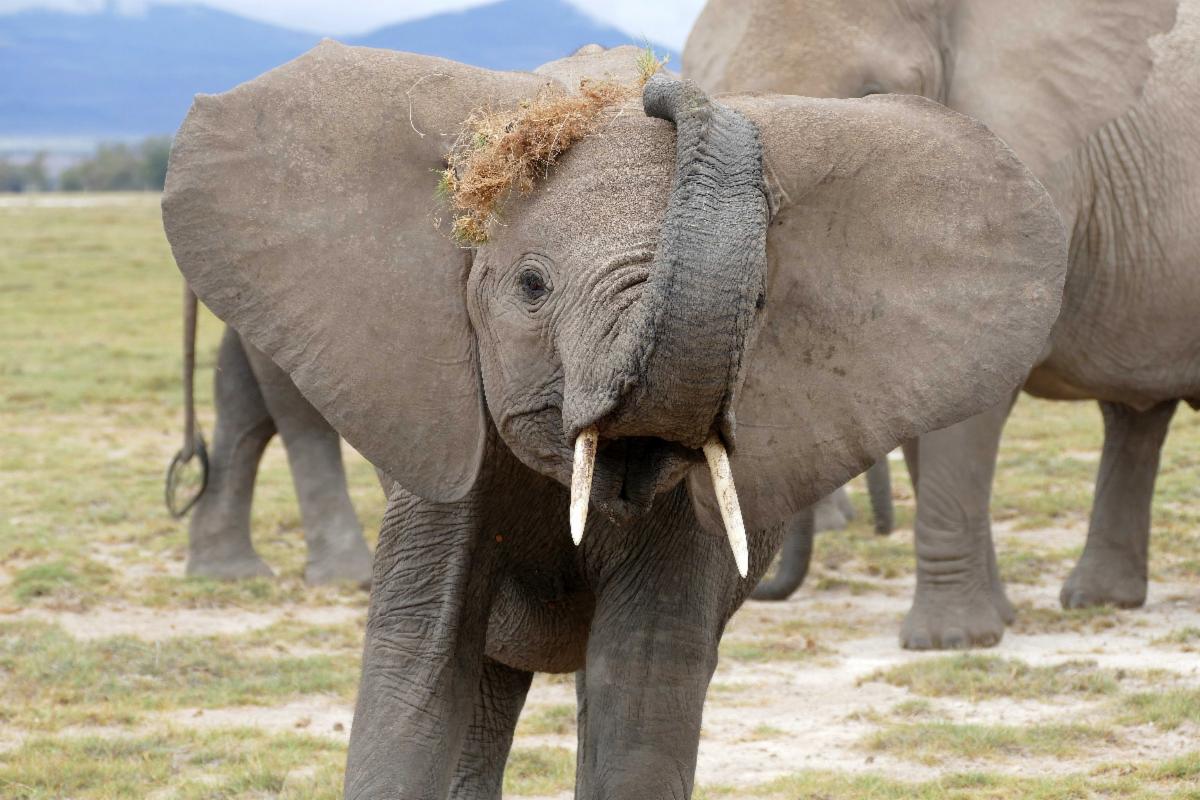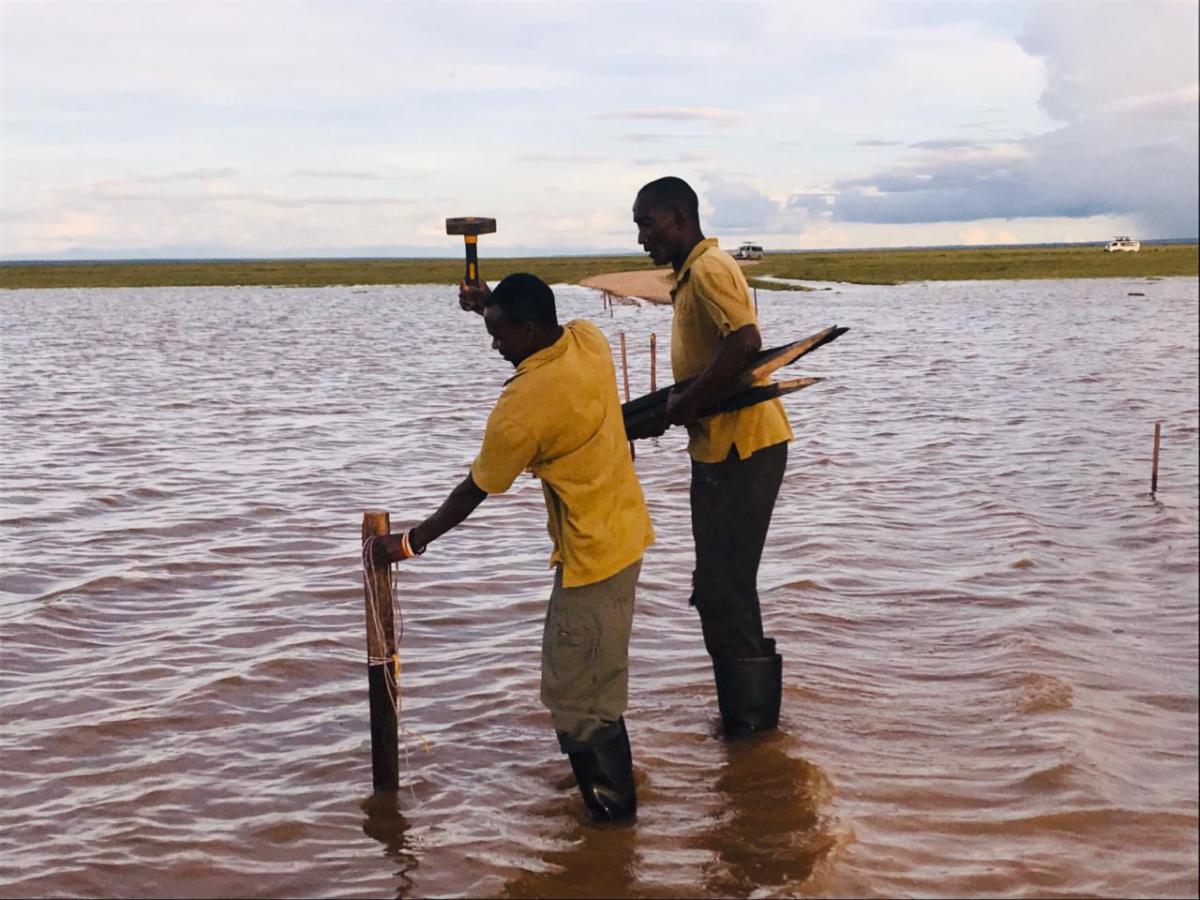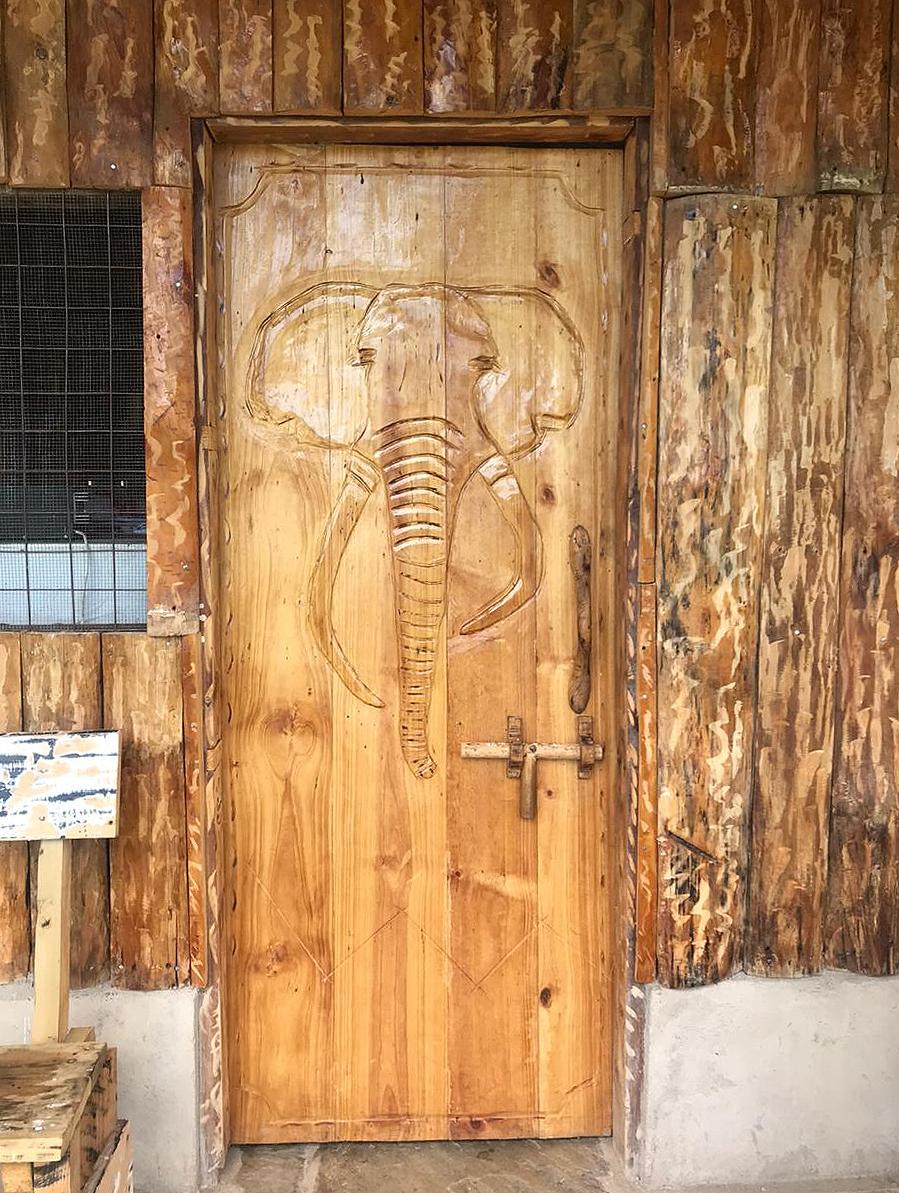
Elodie, an orphan in the EB family, wanted to show off her hat; let's make sure she has a future
|
|
Thanking our Loyal Donors
Nancy Biglow
Born Free Foundation
Nancy Camp
Leslie Conant
Christian Degner
Elizabeth Dewey
Patricia Ellsworth
Tamra Fine
Kindy French
Bruce Friedrich and Alka
Chandna
Jonathan B. Gifford Family Foundation
Judie Graham-Bell
Geneve Greene
Harley Family Foundation
Cynthia Jensen
Peter and Eleanor Nalle
Jan Long
Gretchen Mair
Priya Shah at MiaKora
James Miller
Gordon Ray
Gurcharan Roopra
Joan Russo
Ann Smith
Richard Stanley
Shikha Vincent at Shikhazuri
Michael Wood
Michele Yanko
|
|
Crazy Rain - Again!
|
|
Once again Amboseli is trying to be the lake it once was. We've had exceptionally heavy rain in December. For the first time ever the airstrip is closed, and as normal after so much rain, many of the roads are also closed.
The road to our camp is flooded but still drivable through the water. To stop people driving off the edge, Katito and her team marked the sides of the road. It also helps us, even though we think we remember where the road is!
|

|
|
|
Top: placing those important sticks; Above: Katito with Mwonga (better known as Machinery) and Hezron
|
|
|
Norah Visits ISK
|
|
On the 10th of December Norah visited the International School of Kenya (ISK) in order to talk to the students about elephants, our work, and what each one of us can do to help protect them. Talking to Kenya's future generations is of high importance in order to educate and inspire the young people into making a positive difference for conservation. The children listened carefully and asked very good questions. We hope some future conservationists are among them!
We are a very small team with limited capacity to do these kinds of educational visits on a large scale, but we enjoy doing what we can. We also offer support and educational materials to other organisations doing this kind of work.
|
|
|
|
Norah keeps ISK students spellbound with her elephant stories
|
|
|
A Visit from a US Board Member
|
|
|
|
US Board Member Nan Buzard was delighted with the carving of Tim on the door of our new kitchen
|
|
|
Over the years some of our US board members have visited Amboseli, but it has been quite a while since the last one came. So we were very pleased to host Nan Buzard for three days in November. Nan is based in Geneva as Head of Innovation for the International Committee for the Red Cross. Needless to say, she is full of good ideas and we appreciate her role in the success of ATE.
|
|
Ways to Support Us
Follow an Amboseli Family with Elatia

This is part of the AA family. You could follow this family by joining our Elatia program. We have chosen six Amboseli families for Elatia: the AAs, EBs, FBs, GBs, OAs, and PCs. You can choose one or all of the families to follow. Regular updates include photos and videos, and news of what is going on in the family.
To learn more about Elatia
go to
This Link.
If you have any problems, Tal has made a tutorial for signing up,
Click Here.
You can also contact her directly if you have any questions on:
**********
Name a Baby Elephant
Else's calf born this year will need a name. One way to participate in the Amboseli elephant project is to name a calf.
Unlike our Elatia program where many people follow the same family, our naming program is a unique experience. The calf becomes "your" calf alone and the name you give forms a part of the Amboseli dataset for all time. For more information, please write to us at:
info@elephanttrust.org
*********
iGive
One of the ways you can support ATE is by making your online purchases through iGive. If you sign up the Amboseli Trust for Elephants as your recipient organization we will get a small percentage of the sale. Connect with
iGive.
Give a Gift that Lasts Forever
Designate the Amboseli Trust for Elephants as a beneficiary of your will, individual retirement account, or life insurance policy. To learn more about planned giving opportunities, please contact Betsy Swart:
Tel +1-508-783-8308.
|
|
|
News from the Amboseli Trust for Elephants
October - December 2019
|
|
Well, we weren't expecting this much rain. After the unprecedented rain in 2018, we thought we would probably have a normal year in 2019. After a lower-than-average "long rains" from March to May, we were going along as usual in October but then in late November it started to pour and December has been wild. So far 224mm of rain have fallen in the first 11 days--two thirds of our average annual rainfall. As a result most of the roads are closed and, for the first time in the Park's history, the airstrip is closed. Needless to say, this is causing huge disruptions to tourism.
On the other hand, the elephants are loving it. The rain has brought up rich, nutritious grasses and herbs, which they are eating with great relish. Because there is so much high-quality food available, the elephants don't have to spend as much time eating. That means they can socialize, play, and simply enjoy each other's company.
If there is one thing we can definitely conclude from our observations it is that elephants are very social animals. If conditions allow they will gather in large aggregations. In November Katito recorded a group of 450. It is a joy to be with them in one of these massive groups. At times like this we can see who elephants are, what their lives can be, and we know that we must do everything we can to conserve not just elephant numbers but their whole complex and wonderful way of life.
As we go into the new year and a new decade, please consider supporting the work we do to continue to understand elephants and to make sure they have a future. We cannot do it without your support.
Cynthia Moss
Director
Amboseli Trust for Elephants
|
|
|
A New Heart for the Camp
We are ridiculously proud of our new kitchen. The old one lasted just short of 30 years so it is not surprising that we needed to tear it down and build a new one. We knew it was needed because we were starting to get visits from mice and snakes, but when the baboons did a huge raid and ripped a hole in one wall we knew it was an emergency situation! Our new kitchen is airier, lighter and bigger, and features a beautiful carving of Tim on the door. We're looking forward to cooking our first Christmas dinner in it.
 
|
|
ATE's Scholarship Program
Where are they now?
Maintaining the balance of coexistence in Amboseli is paramount for the ecosystem's success. Our wildlife depends heavily on the local people, spending more than 70% of the time on community land. Education is a key factor in the coexistence story because it empowers choice and allows a clearer vision of how progress can be interlinked with conservation. In recognition of the potential of education, ATE has supported scholarships for members of the Amboseli community since 2002.
Meet Patrick Ole Papatiti. He is one of our ex-students who now holds an important role in wildlife and community conservation in the Amboseli ecosystem. We asked him to write a brief story about his life, how he became our student, and why he chose to protect the natural resources of his homeland. Here is his story:
I was born and raised in Loolakirr (north of Amboseli). I was a young and a good warrior, through this one day I joined a lion hunt that changed my view of wildlife; a lioness that attacked a bull in my family herd got killed, with my colleagues we speared and killed it and I was attacked badly by the same lioness. During my stay at the hospital one night I asked myself what worth would losing my life through this act help my community, since as a warrior my responsibility is to protect my family livestock. Livestock and wildlife to me became one, the death of the two (the bull and lioness) and my survival was the turning point and inseparable in my life.
In 2002 I joined ATE as a scout, and it was through that position that I became aware of their scholarship program. For a little history, I come from a poor background and couldn't join high school when I finished primary school in 1990. I was out of school for 13 years; I went back and started high school at 27 years, joining Form 1. I was married and had one child who was born in 2003, I joined Form 1 in 2004. I finished high school in 2007 and with a promise Cynthia made to me that when I finish high school and got grades to join university ATE will give me a scholarship, I got a B grade and ATE fulfilled the promise.
I attended the United States International University-Africa and I got a GPA of 3.1. I studied International Business Administration (major),
Entrepreneurship (minor). The course was for four years.
I tried politics immediately I finished University in 2012, but that did not work well. I joined the Kenya National Assembly in 2013 as Liaison Officer in the office of the Majority Whip. After my contract ended in 2017, I applied for a different position. While I was waiting to join, an issue arose between OOGR [the group ranch outside Amboseli National Park] and the BLF [Big Life Foundation], which led to me being engaged as a consultant by OOGR. I was asked to help them set up an organisation since they did not have such expertise. I volunteered for two months to set up the
organisation
, still planning to go back to my job, but my love for wildlife conservation made me change my mind. I had a better job and a better salary but I could not resist. I decided to help my community and wildlife, both close to my heart.
|
|
| Patrick with his wife and mother at his graduation |
|
The History of the LD Family
The LD family has had a very interesting history. It started out as part of the LB family, which was one of the immigrant groups that moved into the central region of Amboseli in the late 1970s. I saw the family for the first time on February 9, 1976. Most of the other Amboseli families had been photographed and sighted many times by this date, thus it was a surprise to find this new family. On that occasion there were 17 animals present, including two large adult females, one with two broken off tusks and another with a large bump under her tail. There were also five young females, fortunately all with distinctive features. They had large tears out of their ears or broken tusks and one was tuskless. In addition there was an adolescent female with a neat V out of the top of her right ear, and several young males. Oddly there were few calves: I only noted one calf under the age of four years old.
 |
|
 |
An early ID photo of Lisa |
I saw this family two more times in February, and two times each in March and April. Every time I saw them, including the first, they were very wary of my car, either running away when I approached or getting into defensive formation. This behavior indicated that they were not used to being in the central tourist area of Amboseli. I did not see them again until October 1976 and on that occasion they were extremely agitated. They were also missing the broken two-tusked female. I never saw her again. However, from that day on, the family, designated the LB group was sighted regularly on a monthly basis. I believe the core of their home range had been one of the swamps to the east of the Park and that they were forced to leave when people began to cultivate in the area. Broken Two Tusks was probably killed in a conflict with the farmers. Four other families appeared to move in at the same time. All became permanent residents in Amboseli and eventually began to calm down and tolerate vehicles.
Because the LB females were easy to recognize it did not take me long to work out who belonged in the family. The matriarch was called "Bump-Tail" for a long time, but eventually I named her Leticia and gave the other females 'L' names as well. In 1977 the family numbered 10 and was composed of the following members:
Leticia (Bump-Tail)
C'73
Lana-8-year-old female, V-nick high right
Lucia-teenage female
Leana-teenage female
Laura-about 10-year-old-female
Lisa-about 8-year-old adolescent
Lolita-tuskless 6-year-old calf
YM-10-11 years old
YM-14-15 years old
To read the full history and to learn how the LDs started their own family
Click Here.
|
|
|
We wish all our supporters and friends Merry Christmas, Happy Holidays and a peaceful, safe New Year for everyone including the elephants.
|
|
|